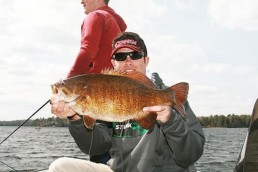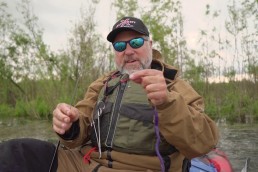Get ‘Edgy’ for More Bass
SHARE THIS POST
Look out over a cornfield that butts up against a patch of woods later in the day in March or April and you’re liable to see grayish, ghostlike figures waiting patiently where the two parcels of land meet. Odds are good you’re seeing a herd of deer waiting for the sun to drop a little more so they can move into the field to forge on remnants of last year’s corn. If you were to draw a line along the trees you’d find it forms an edge.
When deer need shelter and protection they move into the trees. When they are active they’ll come out from the edges to look for theair next meal. In fishing, you call it a “line” or an “edge” too. Whenever you find the area where the cover stops in the water, you then have a better chance of locating the bass and the hot spots. Then it’s just a matter of picking the right bait.
Edges do come in all shapes and sizes, and can be comprised of natural or man-made elements.
Weeds typically form the edges. The most obvious are the insides of weed edges that form in spring as new weed growth develops. That’s an edge that you can visually see in shallow water. Deep-weed edges are harder to find as they can develop in up to 20 feet or more, especially in clear-water lakes. However, when you find a shallow inside weed edge, you can bet there will be a deeper edge as the weeds continue to grow as long as they get sunlight. Where the light penetration ends, the deep weed edge forms. Track it with your depth finder and use your lures to work in and out of the edge where active fish reside.
Another weed edge that’s always worth fishing is where one type of weed gives way to another type. Often, this indicates a change in bottom composition. For whatever reason fish relate to this change—and experienced anglers know it. It could be where lily pads meet cabbage weeds or where cabbage meets another common aquatic plant like coontail. These are good areas to use swim jigs and stick worms through the weeds. Plastic frogs work as a good weedless topwater bait, and the heavier jigs and plastic worms produce well on these edges and the deeper weed pockets.
Other visible edges include trees and laydowns, stumps with root systems, rock riprap, concrete and wood retaining walls and boat docks. Trees and laydowns can be fished with shallow square-bill crankbaits like the Bill Lewis Echo. These help the bait deflect off the wood rather than cause it to hang up. Jigs can also be worked in among the branches as well as on the root edges of stumps. Surface baits like a Rebel Pop-R or a single or double prop bait can be worked over the root systems. Spinnerbaits, buzzbaits and bladed jigs like the Z-Man ChatterBait can also be used around the wood cover edges.
Deep-diving crankbaits and bladed jigs work well on rocky riprap. The deeper the rock goes, the better the chance it holds fish. You can find fish right where the rock meets the deeper water and where bottom composition changes. If the bass are not chasing, fluttering down a weedless rigged Senko or plastic fluke-type bait can get you bit. Retaining walls generally have areas of rock and rubble that were used to brace the wall when it was originally built. These little outcroppings along the base of the wall can be fish magnets. Run crankbaits along these walls or slow down and fish each outcropping with a jig.
Boat docks offer shade and hiding places close to areas the baitfish and panfish call home. They can be ultra-productive on waters where there is not much natural cover (lakes shaped like bowls or dishpans and without distinctive depth changes). Skipping jigs up under the docks is always worth a shot. The best docks are usually closer to deeper water and may have something unique like shallow weed growth or a laydown close by.
Are you enjoying this post?
You can be among the first to get the latest info on where to go, what to use and how to use it!
But not all quality edges exist in shallower water. Rock humps, sunken islands and bridges all offer opportunities. Once you locate sunken structure, the edge advice still holds true. It also pays to use your electronics to look for any irregularities on the structure like stumps, logs or high or low points. These unique elements can group fish, and in many cases these sweet spots can hold the most and biggest fish on the structure.
Pay careful attention to newer bridges too, as the older bridges were demolished and replaced with the newer structures. A lot of times the bridge may have been built next to the old one so workers could work parallel to the old site as they built the newer bridge. Often, the discarded construction materials and remnants of the old bridge were just piled off to the side. They now create their own submerged humps, and bass are thankful for them.
There are several other edges that are not always formed by actual physical borders. A heavy rain can wash dirt from the shore and into nearshore areas and then farther into the water. This debris can extend out, forming a mud line that creates a cloudy water shelter. Gamefish will infiltrate the outer edges and use these as ambush points for their next meal. Also, ripples from a steady wind can break up light penetration, which can allow the bass to come shallower. Once again, they are using Mother Nature’s edge to hunt from.
One more area worth several casts is a current break created when wind pushes through a “neck” or where it narrows in a shoreline. Food can then be funneled through this neck, which draws forage from minnows to panfish. Gamefish are usually not far behind, setting up on the current edge formed by the water push. Areas like this may not produce if the wind is not blowing, so it can be a situational opportunity.
No matter what style of fishing you enjoy, you can find edges that favor that style. From plastic worms on weedlines to jigs on sunken islands to crankbaits along retaining walls to surface baits over weed beds and stump roots, you should find something that works. And, you might find more than just bass using a lot of these edges, so get “edgy” on your next trip out.
This river bass came from a laydown jutting out from shore.
This early-season largemouth was waiting to spawn on a shallow inside weed edge.
MWO
SHARE THIS POST
You may also like...
0 CommentsGreat Shallow-water Bass Action Right Now
Did you enjoy this post?
You can be among the first to get the latest info on where to go, what to use and how to use it!
Tom Luba
Tom Luba is a freelance outdoor writer living in New London, Wis. He has written about open water fishing for more than 35 years.


